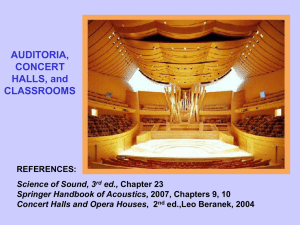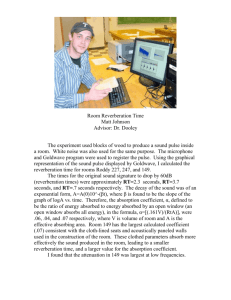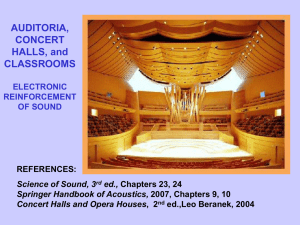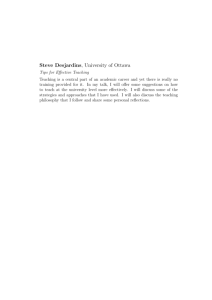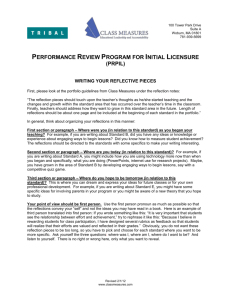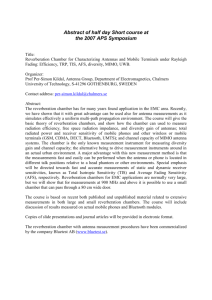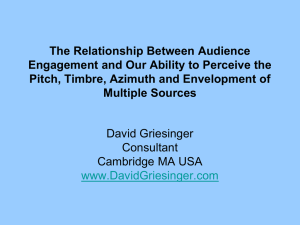Why do concert halls sound different
advertisement
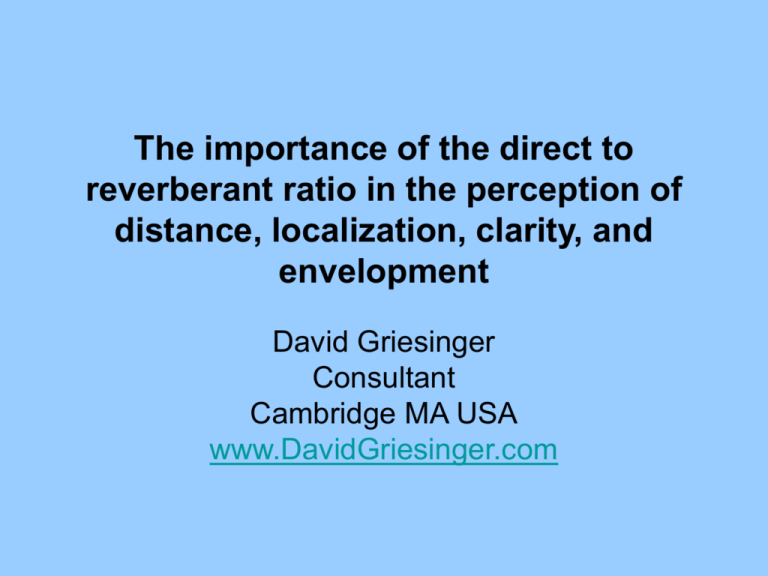
The importance of the direct to reverberant ratio in the perception of distance, localization, clarity, and envelopment David Griesinger Consultant Cambridge MA USA www.DavidGriesinger.com Introduction • Sound engineers need (almost) no convincing about the importance of direct sound. – The sound image in most popular recordings is built from close-miked sources. – Reverberation is added later as an enhancement, the sauce that holds the sound together. • There is a fiction among classical engineers that the “hauptmicrophone” picks up the direct sound – But in practice the image is created by accents, and the main mike adds some early reflections. • My research into spatial acoustics started with sound recording, and the hall research of Michael Barron. Barron’s Spatial Impression Diagram Barron started with direct sound in front of listener and added a single reflection at 40 degrees from the front. The diagram plots the spatial impression that resulted as a function of time delay and the ratio of the reverberation to direct (R/D). The range is -25dB tp +5dB My research • I used a similar setup, but employed six or more reflections at various angles and delays. – I obtained similar results – and found it was the total energy of the delays that mattered, not the amplitude of the individual reflections. – The theory of how the ear detects such reflections in the presence of music followed, with many interesting results. – But the range of the energy of the reflections was the same as Barron’s – about -25dB to +5dB with respect to the direct. • In this talk I will refer to the Direct to Reverberant ratio (D/R). In terms of D/R, Barron’s range is +25dB to -5dB. Results for D/R=+25dB to 0dB • Dry speech – Note the sound is uncomfortably close • Mix of dry with early reflections at -5dB. (D/R = +5dB) – The mix has distance (depth), and is not muddy! – Note there is no apparent reverberation, just depth. • Same but with the reflections delayed 20ms at -5dB. (+5dB D/R) – Note also that with the additional delay the reflections begin to be heard as discrete echos. • But the apparent distance remains the same. • Same but with the reflections delayed 50ms at -3dB (+3dB D/R) – Now the sound is becoming garbled. These reflections are undesirable! – If the speech were faster it would be difficult to understand. • Same but with reflections delayed 150ms at -12dB (+12dB D/R) – I also added a few reflections between 20 and 80ms at a level of -8dB to smooth the decay. – Note the strong hall sense, and the lack of muddiness. • Note the Late reflections are at least 7dB more audible than the early ones!!! And the sense of hall is all in the late reflections!!! Preference and Practice • In recording practice the D/R for the combination of early and late reflections is nearly always between +4 and +6dB – If you give an engineer a control which varies D/R, and ask them to set an optimum value, this is what they choose. – Acousticians (including Beranek) choose the same values. • Regardless of the material, reverberation in reproduced music should be strong enough to be audible, – And weak enough not to reduce intelligibility or clarity • These values of D/R are optimums based on human hearing and the properties of music. – Otherwise engineers, producers, conductors and musicians would insist on something else. • But these are NOT the values of D/R found in halls! Concert Halls • Barron was interested in halls, not recordings! – The critical distance in Boston Symphony Hall (BSH) is ~ 7meters. – At this distance the D/R is 0dB. Almost all the listeners are beyond this distance. The average D/R is below -8dB. • In halls the majority of the loudness is in the reflections – Otherwise the music would not be loud enough throughout the hall. • When we experiment with D/R values less than 0 very different results emerge. – And the results have large – and controversial – implications for hall design. Experiences – Staatsoper Berlin Barenboim gave Albrecht Krieger and I 20 minutes to adjust the LARES system in the Staatsoper. My initial setting was much to strong for Barenboim. He wanted the singers to be absolutely clear, with the orchestra rich and full – a seemingly impossible task. Adding a filter to reduce the reverberant level above 500Hz by 6dB made the sound ideal for him. The house continues with this setting today for every opera. Ballet uses more of a concert hall setting – which sounds amazingly good. In this example the singers have high clarity and presence. The orchestra is rich. Experiences – Bolshoi – a famously good hall for opera The Bolshoi is a large space with Lots of velvet. RT is under 1.2 seconds at 1000Hz, and the sound is very dry. Opera here has enormous dramatic intensity – the singers seem to be right in front of you – even in the back of the balconies. It is easy for them to overpower the orchestra This mono clip was recorded in the back of the second balcony. In this clip the orchestra plays the reverberation. The sound is rich and enveloping New Bolshoi before modification The Semperoper was the primary model for the design of the new Bolshoi. As in Dresden the sound on the singers is distant and muddy, and the orchestra is too loud. RT ~1.3 seconds at 1000Hz. New Bolshoi Dresden This theater suffers greatly from having the old Bolshoi next door! What is it about the SOUND of this theater that makes the singers seem so far away? Experiences – Amsterdam Muziektheater • Peter Lockwood and I spent hours adjusting the reverberant level using a remote in the hall. – He taught me to hear the point where the direct sound becomes no longer perceptible, and the sonic distance dramatically increases. – With a 1/2 dB increase in reverberant level, the singer moved back 3-4 meters. – In Copenhagen, I once decreased the D/R by one dB while Michael Schonwandt was conducting a rehearsal. He immediately waved to me from the pit, and told me to put it back. • Given a chance to listen A/B, these conductors choose dramatic intensity over reverberance. – When they do not have this chance, reverberation is seductive, and the singers be damned! Experiences, Copenhagen New Stage We were asked to improve loudness and intelligibility of the actors in this venue. 64 Genelec 1024s surround the audience, driven by two line array microphones, and the LAREAS early delay system. A gate was used to remove reverberation from the inputs. 5 drama directors listened to a live performance of Chekhov with the system on/off every 10 minutes. The result was unanimous – “it works, we don’t like it.” “The system increases the distance between the actors and the audience. I would rather the audience did not hear the words than that this connection is compromised.” INVOLVEMENT, not ENVELOPMENT • All these experiences relate to the importance of the perception of direct sound in drama and opera. I believe the same is true of music. • At the IOA conference in Oslo, Krokstad gave a lecture where he insisted that acousticians needed to provide involvement, not envelopment – And not just for drama and opera, but for chamber music and symphony too. – At the end of the lecture he showed a picture of the Theatre de Colon in Brazil. “Is this the concert hall of the future” he asked? • It is the independent perception of the direct sound that involvement requires – We must learn how to provide this essential element in halls. • I was recently fortunate to hear the Metropolitan Opera performance of Salome in HD at a good theater. – The sound was harsh and dry – but you could hear every syllable of a fabulous performance. – This is the dramatic and sonic experience the audience will increasingly come to demand. Main Points • The ability to hear the Direct Sound – the sound energy that travels to the listener without reflecting – is a vital component of the sound quality in a great hall. – The ability to separately perceive the direct sound when the D/R is less than 0dB requires time. There must be sufficient time between the arrival of the direct sound and the build-up of the reverberation • Hall shape does not scale – Our ability to perceive the direct sound depends on its level compared to reflected sound, and on the time-gap between the two. – Both the direct to reverberant ratio (d/r) and the time-gap change as the hall size scales – but human hearing (and the properties of music) do not change. – A hall shape that provides great sound to a high percentage of 2000 seats may produce a much lower percentage of great seats if it is scaled to 1000. Main Points 2 • Current acoustic measures ignore both the D/R and the time gap between the direct (the first wavefront) and the reverberation. – RT, C80, and EDT all ignore the strength of the direct sound, and the effects of musical style on the audibility of the D/R • The strength of the reverberation depends on the length of a note compared to the reverberation time. Short sounds do not excite a large hall, and the D/R in practice can be much higher than expected from conventional theory. • There need to be gaps between notes sufficiently long that the reverberance decays below the level of the new direct sound. • The direct sound from notes that differ in pitch by at least a musical fifth are easier to distinguish. • We need measures that use binaural recordings of actual performances as inputs. – And the ability to listen to these recordings to test the validity of these measures against the true experience. – Two such measures will be discussed here. – Methods for accurately making and reproducing binaural recordings are discussed in another paper. Diffusing elements do not scale • The audibility of direct sound is frequency dependent. Frequencies above 1000Hz are particularly important – Diffusing elements can cause the D/R to also vary with frequency in ways that improve direct sound audibility. – The best halls (Boston, Amsterdam, Vienna) all have ceiling and side wall elements with box shape and a depth of ~0.4m. • These elements tend to send frequencies above 1000Hz back toward the orchestra and the floor, where they are absorbed. • The result is a lower early and late reverberant level above 1000Hz in the rear of the hall. • This increases the D/R for the rear seats, and improves clarity. • Replacing these elements with smooth curves or with smaller size features does not achieve the same result. – Some evidence of this effect can be seen in IACC80 measurements when the hall and stage are occupied. Sound Build-up in halls, or why do different large halls sound different? • In a large hall – such as Boston Symphony (BSH), or the Amsterdam Concertgebouw (CG) the reverberation decay is nearly identical, but the halls sound different. – I decided to examine the way reverberation builds up compared to the direct sound, instead of the way it decays. – I used a simple binaural image-source model with HRTFs measured from my own eardrums. Reverberation build-up and decay – from models Amsterdam Boston The upward dashed curve shows the theoretical exponential rise of reverberant energy from a continuous source. The seat position in the model has been chosen so that the D/R is -10dB for a continuous note. The upward solid line shows the actual build-up, and the downward solid line shows the decay from a shorter note – here a 100ms excitation. Note the actual D/R for the short note is only about 6dB. T10 – the time for the reverberation to rise to 1/10 the final energy – is less in Boston than in Amsterdam, but after about 50ms the curves are nearly identical. (Without the direct sound they sound identical.) Smaller halls • What if we build a hall with the shape of BSH, but half the size? – The new hall will hold about 600 seats. – The RT will be half, or about 1 second. – We would expect the average D/R to be the same. Is it? How does the new hall sound? – If the client specifies a 1.7s RT will this make the new hall better, or worse? Half-Size Boston The gap between the direct and the reverberation and the RT have become half as long. Additionally, in spite of the shorter RT, the D/R has decreased from about -6 in the large BSH model, to about -8.5 in the half-size model. This is because the reverberation builds-up quicker and stronger in the smaller hall. The direct sound, which was distinct in more than 50% of the seats in the large hall will be audible in fewer than 30% of the seats in the small hall. If the client insists on increasing the RT by reducing absorption, the D/R will be further reduced, unless the hall shape is changed to increase the cubic volume. The client and the architects expect the new hall to sound like BSH – but they, and the audience, will be disappointed. As Leo Beranek said about the Berlin Philharmonie: “They can always sell the bad seats to tourists.” An existing small hall An existing small hall of 350 seats has a measured RT of 1.0s The sound in the first few rows is loud and harsh. In the middle 3 rows it has a good balance between direct and reverberation. The remainder of the seats (where most of the audience sits) have a muddy sound and poor localization. Note that the time gap between the direct and the reverberation is even shorter than the half-Boston The D/R has decreased further, from-8.5 to less than -10dB. It is impossible to increase the volume of this hall. How can we improve the acoustics? 1. The earliest reflections to the floor (the first laterals and the stage back wall) can be reduced through diffusion or absorption. This will increase the time gap. 2. The reverberation time must be increased – but in a frequency dependent fashion, and with a lower level. This can only be done electronically. An existing small hall - pictures Note the highly reflective stage and side walls, deeply coffered ceiling, and relatively low internal volume per seat. The sound in most seats is muddy. Adding reflections or decreasing absorption will only make the situation worse. Compare this to Williams Hall – coming up Small shoebox halls can be OK • If the client insists on a shoebox it can work by building a large hall and installing a small number of seats. – I was just in such a small hall in Helsinki, and at least half the seats were OK. • But this is not the ideal solution. – With a different shape nearly all the seats could have been OK – and it might have been less expensive. Great Small Halls Exist! Jordan Hall at New England Conservatory has 1200 seats, an RT of 1.3s occupied. The shape is half-octagonal, with a high ceiling. The audience surrounds the stage, with a single high balcony. The average seating distance is much shorter than a shoebox hall, increasing the direct sound. The high internal volume allows a longer RT with low reverberant level. The sound in nearly every seat is clear and direct, with a marvelous surrounding reverberation. Although the hall is renowned as a chamber music hall, it is also ideal for small orchestras and choral performances. It was built in about 1905. The hall is in constant use – with concerts nearly every night, (and many afternoons.) Williams Hall, NEC • Williams hall, in the same building, has ~350 seats in a square plan with a high ceiling. • Once again the sound is clear and reverberant in most, if not all, seats. The audience usually sits where the orchestra is rehearsing in this picture. The square plan keeps the average seating distance low. The high ceiling and high single balcony provides a long RT without a high reverberant level. The absorbent stage reduces the reverberant level while keeping the direct sound strong. Note the coffered ceiling – similar to BSH. Hard learned lessons • Where clarity is a problem in small halls, acousticians usually recommend adding early reflections – through a stage shell, side reflectors, etc. • These measures reduce the gap between the direct sound and the reflected energy – They increase the sense of distance to the performers, and the muddiness. – They also increase loudness, which is almost always too high already • A better way is to add absorption, or perhaps diffusion, to reduce the level of the earliest reflections. – Small halls have strong direct sound and too many early reflections The reflections also come too quickly Adding more reflections is exactly the wrong thing to do. – Adding absorption will improve clarity but reduce the late reverberant level and the RT. Electronics, or more cubic volume, can restore the longer RT without decreasing the D/R • Adding absorption is NOT recommended unless the decrease in late reverberation can be compensated. • If electronics are used they must be on all the time. Clarity and involvement come from the direct sound. Spaciousness and envelopment are provided by LATE energy. • Reflections in the time range of 50 to 100ms can increase loudness – but tend to reduce clarity and intelligibility. – Reflections from 20 to 50ms can increase intelligibility – but they decrease involvement. • A few Early lateral reflections can help blend together the orchestra image, but they do not provide significant envelopment. – When the direct sound is adequate for localization, and there is lots of late reverberation, the spatial perception of early reflections is inhibited. • You can often make the reflections in the time range of 20ms to 80ms monaural with no change in sound. • A hall with good reverberance will emphasize late reverberation over early reflections – And ideally it should provide a lower level of reverberation above 1000Hz in the back of the hall. • This will provide loudness and clarity to the largest number of seats. Why do current acousticians emphasize early reflections? • I believe the current emphasis on early reflections (which include reflections in the deadly range of 50-80ms) is a result of a misapplication of Barron’s data for D/R greater than 0dB. • When D/R is below 0dB we find that it is the spatial properties of the late reverberation that dominate perception. • The correlation between hall quality and “early time delay gap” found by Leo Beranek applies only to large halls. – In a large hall excessive width can lead to disturbing echoes in some seats. – Leo told me his interest in the subject started when he was working in such a hall. • Our work shows that there may be an optimum delay gap. – The ~ 25 ms observed in BSH may be close to that optimum. – The Amsterdam hall, which is both clearer and more reverberant, sometimes has echoes – particularly on solo piano. – The Musikverrein in Vienna has a shorter gap, and a longer RT than BSH. Seats in the rear half of the hall sound muddy and distant to this author. • Best to sell them to tourists… • The standing room (under the balcony) is surprisingly good! Threshold Data • Onset and azimuth thresholds allow hall sound to be predicted from models! • 1. Thresholds for azimuth detection. – Azimuth experiments are simple, and repeatable. • 2. Thresholds for onset enhancement – Onset enhancement is also easy to quantify. • 3. Thresholds for elevation detection. – Work is on-going. Accurate HRTFs are needed in models • 4. Thresholds for diffuse field detection – Also depends on accurate HRTFs • We have a data set of HRTFs from a precise model of a single individual, including the ear canal and eardrum impedance. – This data is available for the asking… Experiment for threshold of Azimuth Detection in halls A model is constructed with a source position on the left, and another source on the right Source signal alternates between the left and a right position. When the d/r is less than about minus 13dB both sources are perceived in the middle. Subject varies the d/r, and reports the value of d/r that separates the two sources by half the actual angle. This is the threshold value for azimuth detection for this model (Above this threshold the subject also reports a decrease in subjective distance) Threshold for azimuth detection as a function of T10 As the time gap between the direct sound and the reverberation increases, the threshold for azimuth detection goes down. As the time gap between notes increases (allowing reverberation to decay) the threshold goes down. To duplicate the actual perception in small halls I need a 50ms gap between notes. An important caveat! • All these thresholds were measured without visual cues • The author has found that in a concert (with occasional visual input) instruments (such as a string quartet) are perceived as clearly localized and spread. • When I record the sound with probes at my own eardrums, and play it back through calibrated earphones the sound seems highly accurate, but localization often disappears! – Without visual cues when the d/r is below threshold the individual instruments are localized and spread when they play solo, but collapse to the center when they play together. – My brain will not allow me to detect this collapse when I am in the concert hall – even if I close my eyes most of the time! – With eyes closed it is more difficult to separate the sounds of the individuals, such as the second violin and the viola. This difficulty persists in the binaural recording. How to use the Thresholds • These thresholds provide guidelines for hall design. As a first approximation the d/r value can come directly from classical acoustics, where for typical hall absorption and an RT of 2s: d/r ~= 20*log10(0.14*sqrt(R)/d_source) + d_source/30 Where: R = room constant = S*a_av/(1-a_av) S = total surface area d_source = source distance in ft a_av = average absorption coefficient d/r scales with hall dimensions as long as the source to listener distance decreases linearly with the sqrt of the area. (And the music uses shorter notes by the same factor!) But the time gap decreases – and if a_av is reduced to keep RT constant, than d/r will decreases also. The net result is that localization decreases in small halls unless the shape is changed. In practice the D/R is different than expected from classical acoustics • The D/R is frequency dependent in halls, and the D/R above 1000Hz is critically important for the detection of direct sound and musical involvement. • Surface features can be used to increase D/R at higher frequencies. • In addition, the distribution of absorption in a hall significantly alters the distribution of the D/R. – A high ceiling with a lot of reflecting surfaces above the audience can increase RT without reducing the average D/R, because there is less excitation of the more distant volume, and the reverberation created tends to stay up high. – Effort should be to keep the D/R above ~700Hz as constant as possible over the maximum number of seats. – Current modeling techniques may not properly calculate these effects. • Old fashioned light models might work better… Light models I ran across these pictures while cleaning out my office. The top one is a too-simple model of the Philadelphia Academy of Music. The bottom is intended to be BSH, but with a single balcony. I abandoned light modeling because it does NOT provide any information about the time delay gap – nor information about the effects of note length on D/R. But it DOES provide information about the D/R – the total reverberant energy compared to the direct. And very complex hall shapes can be quickly modeled. Modeling T10 • Classical acoustics predicts a starting value for d/r. We can make a chart of d/r values in all the seats of a proposed hall. • T10 does not follow easily from classical acoustics, but can be predicted with fair accuracy with a simple computer model of the hall. Just the basic hall dimensions are needed. • From this data we can predict the localizability of sound in all the seats. – The results can be surprising! – Auralization from these models (given accurate HRTFs) can be convincing. Onset Enhancement When d/r is low a small amount of direct sound sharpens the perceived onset of sounds, so that a tone with a slow rise – like a cello – is perceived more like a piano. The threshold for this effect is lower than for azimuth detection, and surprisingly, the highest threshold is for the 1kHz band. This result is mysterious…. Small Hall Shapes Above threshold Near threshold Below threshold A large hall like Boston has many seats above threshold, and many that are near threshold If this hall is reduced in size while preserving the shape, many seats are below threshold It is better to use a design that reduces the average seating distance, using a high ceiling to increase volume. Boston is blessed with two 1200 seat halls with the third shape, Jordan Hall at New England Conservatory, and Sanders Theater at Harvard. The sound for chamber music and small orchestras is fantastic. RT ~ 1.4 to 1.5 seconds. Clarity is very high – you can hear every note – and envelopment is good. Retro reflectors above 1000Hz Boston, Amsterdam, and Vienna all have side-wall and ceiling elements that reflect frequencies above 1000Hz back to the stage and to the audience close to the stage. This sound is absorbed – reducing the reverberant level in the rear of the hall without changing the RT. Another classic example is the orchestra shell at the Tanglewood Music Festival Shed, designed by Russell Johnson and Leo Beranek. Many modern halls lack these useful features!!! High frequency retro reflectors Rectangular wall features scatter in three dimensions – visualize these with the underside of the first and second balconies. High frequencies are reflected back to the stage and to the audience in the front of the hall. The direct sound is strong there. These reflections are not easily audible, but they contribute to orchestral blend. But this energy is absorbed, and thus REMOVED from the late reverberation – which improves clarity for seats in the back of the hall. Examples: Amsterdam, Boston, Vienna High frequency overhead filters A canopy made of surfaces separated by some distance becomes a high frequency filter. Low frequencies pass through, exciting the full volume of the hall. High frequencies are reflected down into the audience, where they are absorbed. Examples: Tanglewood Music Shed, Davies Hall San Francisco In my experience (and Beranek’s) these panels improve Tanglewood enormously. They reduce the HF reverberant level in the back of the hall, improving clarity. The sound is amazingly good, in spite of RT > 3s. In Davies Hall the panels make the sound in the dress circle and balcony both clear and reverberant at the same time. Very fine… (But the sound in the stalls can be harsh and elevated.) Binaural Measures The author has been recording performances binaurally for years. Current technology uses probe microphones at the eardrums. We can use these recordings to make objective measurements of halls and operas. The methods use a hearing model where the binaural signal is first filtered into 1/3 octave bands, and then is rectified and filtered. For measures of localization a running IACC is calculated in 10ms overlapping windows. The maximum values of 1/(1-IACC) are then plotted as a surface over time and frequency band. Localization The figure shows the number of times per second that a solo violin can be localized from row 4 of a small shoebox hall (~500 seats) near Helsinki. It also shows the perceived azimuth of the violin As can be seen, the localization – achieved at the onsets of notes – is quite good, and the azimuth, ~10 degrees to the left of center, is accurate. Localization – surface1 Here we plot the same data for the violin as a function of (inverse) azimuth, and the third octave frequency band. As can be seen, for this instrument the principle localization components come at about 1300Hz. Interestingly, Human ability to detect azimuth, as shown in the threshold data, is maximum at this frequency. Localization, Surface 2 Here we plot 1/(1-IACC) as a function of time and third octave band. Note that the IACC peaks at the onset of notes can have quite high values for a brief time. This happens when there is sufficient delay between the direct and the reverberation, and sufficient D/R. Localization – a poor seat Here is a similar diagram for a solo violin in row 11 of the same hall. The sound here is unclear, and the localization of the violin is poor. As can be seen, the number of localizations per second is low (in this case the value really depends on the setting of the threshold in the software). Perhaps more tellingly, the azimuth detected seems random. This is really just noise, and is perceived as such. Measures based on harmonic coherence • When the formant frequencies above 1000Hz are disturbed by reflections, the phase relationship between harmonics of solo instruments is randomized. • The result is highly audible, and is a primary cue for the distance of an actor, singer, or soloist. – The perception has been described by Zwicker as “roughness”. • This effect can be easily measured, and is sensitive both to medial and lateral reflections. This graph shows the audible fundamental components in the formant frequencies as a function of time. The vertical axis shows the effective D/R ratio at the beginning of two notes from an opera singer in Oslo to the front of the third balcony (fully occupied.) The sound there is often muddy, but the fundamental pitch of this singer came through strongly at the beginning of two notes. He seemed to be speaking directly to me, and I liked it. Another singer The king (in Verdi’s Don Carlos) on the other hand, in his wonderful solo aria, was not able to reach the third balcony with the same strength. Like the localization graph shown previously, this graph seems to be mostly noise. The fundamental pitches are not well defined. The singer seemed muddy and far away. His aria can be heart-rending – but here it was somewhat muted by the acoustics. We were watching the king feel powerless and forlorn. We were not involved. Some demos of eardrum recordings • These recordings have been equalized for loudspeaker reproduction. You may be able to judge clarity and intelligibility over near-field loudspeakers. – Accurate headphone reproduction requires headphone equalization – If probes are available the method described here will work, – A method which uses equal loudness curves will be described later in this paper. • opera balcony 2, seat 11 – Moderate intelligibility, reverberant sound. – OK for non-Italian speakers with subtitles • opera balcony 3, seat 12 – Poor intelligibility, very reverberant • opera standing room – Deep under balcony 2 – good intelligibility – This was preferred by Italian speakers • A concert hall – row 8 (quite close) – Very good sound. Not so good further back. Conclusions • • • Performance venues should maximize involvement, not envelopment To achieve this goal the direct sound must be perceived by the brain as distinct from the reflected energy – and this includes early reflections from all directions. The optimum value for the d/r ratio depends on the hall size – – The D/R ratio must increase as hall size is reduced if clarity is to be maintained. – D/R can be increased by decreasing the average seating distance, decreasing the reverberation time, increasing the hall volume, or by careful use of rectangular diffusing elements. – This is particularly true in opera houses and halls designed for chamber music. – A 1.8 second reverberation time is NOT necessarily ideal in a 1000 seat hall!!! Remember that changes in reverberant LEVEL (D/R) are far more audible than changes in RT. • To maintain clarity, low sonic distance, and azimuth detection in a small hall it is desirable to reduce the average seating distance, and widely diffuse or absorb the earliest reflections, whether lateral or not. – The best small halls do this already. • Current hall measurements ignore both the D/R and the time gap between direct and reverberation. – Better measures exist. They must be used if the current practice of hall design is to be improved.
